Quantum nonlocality challenges classical locality by demonstrating correlations between entangled particles that cannot be explained by signals limited to the speed of light, defying classical notions of information transfer. Explore the full article to understand how these contrasting concepts reshape our grasp of reality and impact modern physics.
Table of Comparison
| Aspect | Quantum Nonlocality | Classical Locality |
|---|---|---|
| Definition | Instantaneous correlations between entangled particles, regardless of distance | Interactions occur only through local influences limited by the speed of light |
| Mechanism | Quantum entanglement causing nonlocal effects | Classical fields and forces acting locally |
| Speed | Effects appear instantaneous, beyond light speed constraints | Signals and influences limited to the speed of light |
| Implications | Challenges classical notions of causality and realism | Maintains causality and local cause-effect principles |
| Experimental Evidence | Bell test experiments confirming quantum nonlocal correlations | Consistent with classical physics and everyday experience |
| Examples | Entangled photon pairs exhibiting correlated measurements over distance | Electromagnetic forces propagating via local fields |
Introduction to Quantum Nonlocality and Classical Locality
Quantum nonlocality describes the phenomenon where entangled particles exhibit correlations that cannot be explained by classical local theories, defying the constraints of classical locality which assumes objects are only influenced by their immediate surroundings. Classical locality relies on the principle that information or influence cannot travel faster than the speed of light, preserving causality and separability of distant systems. Understanding this fundamental difference highlights how quantum mechanics challenges your classical intuition about space, time, and information flow.
Defining Quantum Nonlocality: Key Concepts
Quantum nonlocality refers to phenomena where particles exhibit correlations that cannot be explained by any local hidden variable theory, defying classical notions of locality rooted in Einstein's theory of relativity. Key concepts include entanglement, where quantum states of particles become interdependent regardless of distance, and Bell's theorem, which mathematically proves that no local realistic theory can reproduce all quantum predictions. Your understanding of quantum nonlocality challenges the classical idea that objects are only influenced by their immediate surroundings.
The Principles of Classical Locality Explained
Classical locality is based on the principle that objects are directly influenced only by their immediate surroundings, meaning information or physical effects cannot travel faster than the speed of light. This concept ensures that cause and effect relationships follow a predictable, local pattern consistent with relativistic constraints. Classical locality contrasts sharply with quantum nonlocality, where entangled particles exhibit instantaneous correlations regardless of distance, challenging the classical understanding of space and causality.
Historical Development: From Classical to Quantum Worldviews
The historical development of quantum nonlocality contrasts sharply with classical locality rooted in Newtonian physics and Einstein's relativity, which assert that objects are influenced only by their immediate surroundings. The shift began with the EPR paradox in 1935, challenging local realism by demonstrating quantum entanglement's nonlocal correlations that classical theories could not explain. John Bell's theorem in 1964 provided a mathematical framework to test these phenomena experimentally, ultimately confirming quantum mechanics' inherent nonlocality and reshaping our understanding of causality and information transfer in the physical universe.
Quantum Entanglement: The Heart of Nonlocality
Quantum entanglement exemplifies nonlocality by linking particles such that the state of one instantly influences the other, regardless of distance, defying classical locality principles where objects are only affected by immediate surroundings. Experiments violating Bell's inequalities confirm that quantum correlations cannot be explained by any local hidden variables, highlighting the fundamental difference from classical physics. This nonlocal connection challenges conventional notions of causality and information transfer, positioning entanglement at the core of quantum mechanics and emerging quantum technologies.
Bell’s Theorem and Experimental Verifications
Bell's Theorem demonstrates that no local hidden variable theory can reproduce all the predictions of quantum mechanics, highlighting the fundamental difference between quantum nonlocality and classical locality. Experimental verifications, such as those conducted by Alain Aspect and others, have consistently confirmed violations of Bell inequalities, providing strong evidence for quantum entanglement and nonlocal correlations. These results challenge classical notions of locality, supporting the quantum mechanical framework where entangled particles exhibit instantaneous correlations regardless of distance.
Contrasting Information Transfer: Local vs. Nonlocal Effects
Classical locality restricts information transfer to signals traveling at or below the speed of light, ensuring cause and effect occur within light cones. Quantum nonlocality, demonstrated by entanglement phenomena, allows correlations between distant particles instantaneously, without transmitting usable information faster than light. Your understanding of these contrasts reveals that quantum nonlocal effects challenge classical notions of separability but do not enable superluminal communication or violate relativistic causality.
Philosophical Implications of Nonlocality and Locality
Quantum nonlocality challenges the classical notion of locality by suggesting that entangled particles instantaneously influence each other regardless of distance, contradicting Newtonian and relativistic constraints on causality. This phenomenon compels a reevaluation of traditional philosophical assumptions about separability, causation, and the nature of reality, potentially undermining the classical view that objects possess independent, localized properties. Your understanding of reality may need to expand beyond classical frameworks to accommodate nonlocal connections that defy intuitive spatial separations.
Impact on Modern Physics and Technologies
Quantum nonlocality challenges the classical locality principle by demonstrating instant correlations between entangled particles regardless of distance, fundamentally altering our understanding of space and causality. This breakthrough has propelled advancements in quantum computing, cryptography, and teleportation, enabling technologies that outperform classical systems in security and processing power. Your exploration of these phenomena can unlock cutting-edge applications in secure communication networks and quantum information science.
Future Directions and Unresolved Questions
Quantum nonlocality challenges classical locality by demonstrating instantaneous correlations between entangled particles regardless of distance, opening new avenues for quantum communication and cryptography. Future research aims to deepen understanding of the mechanisms underpinning nonlocal effects and to develop practical applications such as quantum networks and secure information transfer. Unresolved questions include the integration of nonlocality with relativity, the foundations of quantum mechanics, and the potential limits of entanglement in complex systems.
quantum nonlocality vs classical locality Infographic

 electrown.com
electrown.com